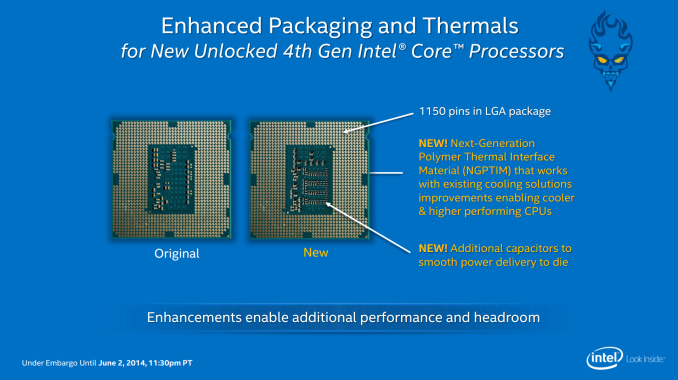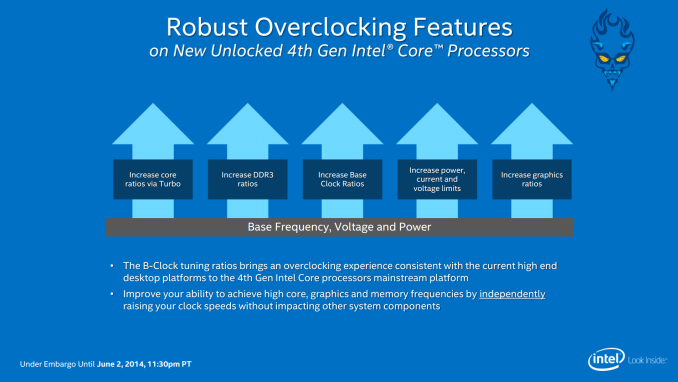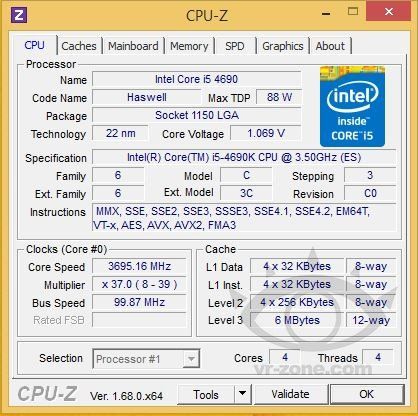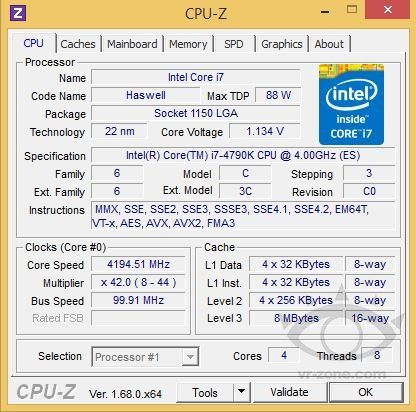Intel Launches Devil’s Canyon and Overclockable Pentium: i7-4790K, i5-4690K and G3258
by Ian Cutress on June 3, 2014 2:30 AM EST- Posted in
- CPUs
- Intel
- Haswell
- Devil's Canyon
- Computex 2014

After what seems like a eon or two since the original announcement, Intel’s Renée James is formally launching the new Devil’s Canyon and Anniversary Edition Pentium processors. In response to enthusiast feedback, and the recent release of the Z97 chipset motherboards, these new processors are designed to improve the overclocking experience for enthusiasts until the next platform enters production.
In the same way as certain other electronic market segments, where the announcement and launch occurs a few weeks before launch, today is actually a paper launch as part of the Computex experience. Review samples for sites like ours should be arriving sometime this week when we can test and dissect the new parts, with a full retailer release later in the month. At present the date is still uncertain: we were hoping to get samples before Computex in order to present results today, but delays have pushed testing and release later down the line. This is in part due to the restricted timescale for these new processors, whereby VP Lisa Graff in a recent press call stated that the Intel engineers had fewer than six months from idea-to-launch.
Devil’s Canyon, the codename for the upgraded Haswell overclocking ‘K’ series SKUs, launches as two parts: an i7 and an i5.
Both models are quad core parts, with the i7 featuring hyperthreading for a total of eight threads. The TDP has a small bump from 84W to 88W, while the official memory support stays at two channels of DDR3-1600. The i7-4790K represents Intel’s first ever consumer processor with a base frequency of 4 GHz (we have CPUs that turbo this high), but the turbo mode for this processor is actually 4-4-3-2, meaning that at single core loads the user will see 4.4 GHz and at full-core loads it will be 4.2 GHz. The i5 is more of a Haswell Refresh-like bump up from its predecessor, with the base frequency and turbo frequencies being moved up a notch.
Compatibility for these processors will be on all Z97 motherboards, and it should extend to Z87 if and only if the motherboard manufacturer has engineered the motherboard to cope with the increased power consumption and also release a relevant BIOS update. I would expect that all the major motherboard manufacturers should announce a full range of 9-series support and a most-of-the-range 8-series support, starting with the most popular products in the 8-series range first (as it all comes down to validation and rewriting BIOS code).
Aside from the base frequency increases, enthusiasts will want to know if the rumor regarding an upgraded package on the CPU is true. I can confirm that Intel has officially made the following changes:
The first upgrade is a new thermal interface material (TIM), which Intel is stating as a ‘next-generation polymer’. This would inevitably imply that the base material is silicone monomer, unless Intel has decided to do something fancy with a carbon-polymer based suspension. With this in mind, users looking to delid their CPUs might see a material the same color as the normal Haswell CPUs, but Intel is stating that this is a new material. One could estimate that another 5-15C shift might occur, allowing those CPUs that were temperature limited to get another 100-200 MHz than they would under the old system. However the issue regarding the height of the heatspreader above the die due to the binding agent has not been mentioned, which would lead me to suggest that it might not have been changed. Until we get a sample in house to test we will not know for sure, but I could perhaps hope that the amount of TIM under the heatspreader has also increased in order to facilitate heat transfer.
For the extreme overclockers using sub-zero cooling, Intel has reworked part of the power delivery around the FIVR to give a cleaner power delivery. Note that none of these changes suggest that any specific change to the underlying silicon die was made, however Intel will be examining the sales of these processors to determine their popularity and whether it is a feature to consider on future platform evolutions.
Also launched today is the new Pentium Processor Anniversary Edition, a fully unlocked 3.2 GHz dual core Pentium and 3MB of L3 cache.
I personally think Intel has missed a trick in not calling this new processor with a ‘K’ moniker, but the 8 on the end should point the CPU out against the myriad of other model names. At $72 for the bulk OEM pricing, this should allow the competitive overclockers to go almost crazy binning (testing to find the best ones) for competitions. The interesting point about the table above is the memory support, set at DDR3-1333. This means that Intel has used a lower bar of entry for the integrated memory controllers on the dies they produce, which might not end well for high memory clocking.
One point of contention for any user that has sought after a high overclocking Haswell CPU in the past is the silicon lottery, whereby CPUs are like chocolate chip cookies. Some cookies have many chips, others have fewer, but the ones made of pure chocolate are the best. Similar analogy to overclocking – some CPUs will hit higher frequencies at lower voltages than others. Haswell processors had a very large swing, with some of the lower performing CPUs (from 3.9 GHz Turbo) only managing 4.2 GHz on air/water cooling compared to the average (4.4-4.5 GHz) and the few awesome ones (5.0 GHz at 1.3 V). Many users tested a half-dozen or a dozen to get the best one of the bunch, and I fear that unless there has been a change at the silicon level, we may see the same with the Devil’s Canyon and Anniversary Pentium models.
CPU-Z screenshots of all three models have been released, confirming many of the details:
As I mentioned, the exact retail release date, as I am writing, is unknown. The embargo for this data is being released at the same time as the Intel Keynote at Computex which is where the official announcing of the new products is happening. Have a read of our live blog on the main page on the keynote to see if an exact date has been chosen! This post will be updated if we get this information.
When we return from Computex we will begin testing the new CPUs, with a plan to show some delidding and see how the new Devil’s Canyon and new Pentium compares to the regular Haswell CPUs both at stock and overclocked. Let me know in the comments if there is anything specific you would like to see in the review.





















53 Comments
View All Comments
AJdaBoss - Tuesday, June 3, 2014 - link
Yeah! 1ST COMMENT!!!!! 4790k ! First intel cpu at 4.0ghz out da box, and only 4 more watts to sacrifice!! Ok waz hoping for more... but atleast the expected finally came way afte r expected time, true devil canyon 6core 12 thread 2015? :P broadwell 2020?BMNify - Tuesday, June 3, 2014 - link
No Sale , No Profit here, they didn't even bother to add a slightly better AVX2 SIMD, or release at least one desktop core with eDRAM GT3e before their new updated version arrives whenever...nothing to see here, move along, those new octacore ARM cortex look nice for my next device spend...
Galatian - Tuesday, June 3, 2014 - link
Wut? If you were considering a 4790K with all it's power, I'm not sure how you can be satisfied with a ARM CPU. That being said, it sound like you are just trolling.BMNify - Tuesday, June 3, 2014 - link
you are of the "one core to fit them all" then !, i however have different uses for different cores/SOC.i already have a i7-4770 but that's irrelevant, im looking for something new that "i want to actually buy" and is worth the costs , it is not here with these re-badges and a process tweak + some good thermal solder they should have used from day one
BMNify - Tuesday, June 3, 2014 - link
"If you were considering a 4790K with all it's power"you also seem to equate 4790K with lots of power over a i7-4770 , i can say for sure you have never taken a standard 1080P blue-ray and put it through http://www.makemkv.com/download/ to make a generic 1080p.mkv with all the subs etc, then ffmpeged it , if you had, you would realize that on visual quality settings -crf 18, high profile, slowest -vf hqdn3d,unsharp=5:5:0.5,gradfun etc its not got "with all it's power" you seem to think it does.
nathanddrews - Tuesday, June 3, 2014 - link
Why compress it further? Storage is cheeeeeeeeeap!BMNify - Tuesday, June 3, 2014 - link
you pick the options on a sliding scale for your need and longer term storage use, in my case i try and hit the sreaming over the LAN to anything i might wish to view on, be it the large hdtv, the android 10" tablets or the pc/linux/other OS im using at the time...for instance i have an average of 600KB 720P files for the android tv stuff, and straight -crf 16 1080P for the hdtv/monitors
BMNify - Tuesday, June 3, 2014 - link
600MB ....piroroadkill - Thursday, June 5, 2014 - link
I prefer an nice single MKV container and a reasonably sized file.No, storage isn't cheap if you store thousands of bluray images.
Galatian - Tuesday, June 3, 2014 - link
Seriously...I'm completly lost by your statements:1.) You claim no improvements
Ok there are only slight improvements if you are coming from a i7-4771, but what about everybody on older chips?
2.) You then go on to claim that an Octacore ARM is a somewhat better proposition.
I already called you out on that one: An Octacore ARM is in a completely different league then a unlocked 88W TDP Core i7.
3.) Upon my previous point you are trying to make a point about "something new that you actually want to buy"
I'm little lost here: you spend money for the hack of it? I mean if you already have a Core i7-4770 then yeah this is not something for you...not sure why you are complaining though?
4.) You are then making the point of ripping/encoding videos.
If you are serious about this, you wouldn't get this processor but rather a HEDT porcecessor, but better yet even a Xeon with even more cores. For everything else Quicksync is fine and included in this processor. Your ARM Octacore will be even slower...so again I'm not sure what your point is?